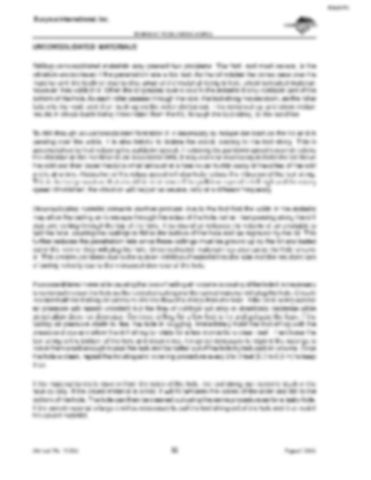BI616959
Bucyrus International, Inc. 59HR ELECTRIC BLAST HOLE DRILL
UNCONSOLIDATED MATERIALS Drilling unconsolidated materials may present two problems. The first, and most severe, is the vibration encountered if the penetration rate is too fast. As the bit rotates the cones pass over the material and the teeth or inserts chip away at the material being drilled. Unconsolidated material, however, has voids in it. When the bit passes over a void in the material it only contacts part of the bottom of the hole. As each roller passes through the void, the tool string moves down, as the roller falls into the void, and then back up as the roller climbs out. This continual up and down motion results in shock loads being transmitted from the bit, through the tool string, to the machine. To drill through an unconsolidated formation it is necessary to reduce the load on the bit as it is passing over the voids. It is also helpful to isolate the shock loading to the tool string. This is accomplished by first reducing the pulldown speed. If reducing the pulldown speed does not reduce the vibration to the machine to an acceptable limit, it may even be necessary to hoist the bit above the void and then lower the bit a small amount at a time so as to chip away at the sides of the void a little at a time. Reduction of the rotary speed will also help reduce the vibration of the tool string. This is the last procedure that should be tried since if the pulldown speed is left high and the rotary speed diminished, the vibration will be just as severe, only at a different frequency. Unconsolidated material presents another problem due to the fact that the voids in the material may allow the bailing air to escape through the sides of the hole, rather than passing along the drill pipe and exiting through the top of the hole. This loss of air reduces the volume of air available to bail the hole, causing the cuttings to fall to the bottom of the hole and be reground by the bit. This further reduces the penetration rate since these cuttings must be ground up by the bit and bailed out of the hole or they will plug the hole. Unconsolidated material may also cause the hole to cave in. This creates problems due to the sudden addition of material into the hole and the resultant loss of bailing velocity due to the increased diameter of the hole. If unconsolidated material is causing the loss of bailing air volume or caving of the hole it is necessary to continually clean the hole as the recycled cuttings or the caved material will plug the hole. Closely monitor both the bailing air pressure and the flow of cuttings from the hole. If the air is being lost the air pressure will remain constant but the flow of cuttings will stop or drastically decrease while penetration does not decrease. Continue drilling for a few feet to try and get past the leak. If the bailing air pressure starts to rise, the hole is plugging. Immediately hoist the tool string until the pressure drops and allow the drill string to rotate for a few moments to clear itself. Then lower the tool string to the bottom of the hole and clean it out. It may be necessary to regrind the cuttings to make them small enough to seal the leak and be bailed out of the hole by reduced air volume. Once the hole is clean, repeat the hoisting and lowering procedure every 2 to 3 feet (0.3 to 0.6 m) to keep it so. If the material tends to cave in from the sides of the hole, the tool string can become stuck in the hole quickly. If the caved material is small, it will fit between the cones of the roller and fall to the bottom of the hole. The hole can then be cleaned out using the same procedure as for a leaky hole. If the caved material is large it will be necessary to pull the tool string out of the hole and then redrill the caved material.
Manual No. 10425
92
August 2006


